大学英语教案怎么写
大学英语教案模板全英文

大学英语教案模板全英文大学英语教案模板全英文篇一:大学英语教案经典模板教案Practical College English新认知大学实用英语综合教程教研室:公共课部教师姓名:freefishwang大学英语教案模板全英文篇二:大学英语教案范本全新版《大学英语》教案课程名称:大学英语(一级)专业:本校05普通本科年级:2005学年:2005-2006学期:第一学期任课教师:全新版《大学英语》板块任课教师Course ScheduleAims:1. Developing Ss’ability of independent learning to be automatic learners.2. Enhancing Ss’ability in using English: improving Ss’five micro-skills—listening,speaking, reading, writing, translation —especially listening andspeaking so that they can communicate in spoken and written English.Required course materials:1. College English (Book 1)—Integrated Curse, Listening and Speaking Course, Reading CourseNote: Reading Course book is used as Ss’self-access material. 2. One Dictionary:Teaching and Learning:1. Keep in mind that it is YOU who have to study to improve your English. If you do not studyby yourself, there is no use in coming to class. In other words, just listening to the teacher and other students in class does not help you improve your English.2. Be well prepared when you come to class. It is of great importance for you to preview thecourse materials before class according to the course schedule. If not, you’ll find it very difficult to follow the class.3. Class participation is vital. You should actively join in pair work or group discussion and dooral presentation before class.4. It is important to turn in any assignments by the due date. Ifyou know that you have acircumstance which will makes it impossible for you to turn in your assignment by the due date, you can and should come to consult with me about your problem beforehand.5. Your essays should be done in a loose-leaf notebook so as to hand in your assignments by aloose paper.6. Since attendance/absence is part of evaluation, keep in mind that your absence will reduceyour evaluation.Useful English Learning Resources:Magazines: English Language Learning, College English, English Salon, English Weekly, The world of English, English Digest, Overseas EnglishNewspaper: 21st Century, China DailyWebsites: (英语比萨园地); (听力快车); (普特英语听力); (英文写作网); (旺旺英语); .cn (中国日报);(华盛顿邮报)Unit 1 Writing For Myself1. 教学目标及基本要求:Objectives:Students will be able to:1) grasp the main idea (the essence of writing is to write what one enjoys writing) and structure of the text (narration in chronological sequence);2) appreciate the narrative skills demonstrated in the text (selection of details, repetition and the use of synonyms.)3) master the key language points and grammatical structures in the text;4) conduct a series of reading, listening, speaking and writing activities related to the theme of the unit.2. 教学内容及学时分配:Time allotment:1st period: pre-reading; text organizationnd2 period: while-reading3 period: post-reading activities4 period: reading practice5th period: speaking6 period: writing3. 教学重点及难点:Important language points in the text:4. 教学内容的深化及拓宽:ththrdStudents conduct a series of reading, listening, speaking and writing practice to deepen their understanding of the points taughtin class.5. 教学方式及在教学中应注意的问题:A combination of traditional teaching methods with the communicative approach will be adopted. Special attention should be paid to classroom interaction. Give students time to adapt to the new teaching mode in the university that are quite different from the one they were used to in the middle school. More encouragement is needed and more guidance will be given to them in their extracurricular study.6. 主要参考书目:季佩英,吴晓真,2001,《全新版大学英语综合教程1-教师用书》。
大学英语阅读课教案
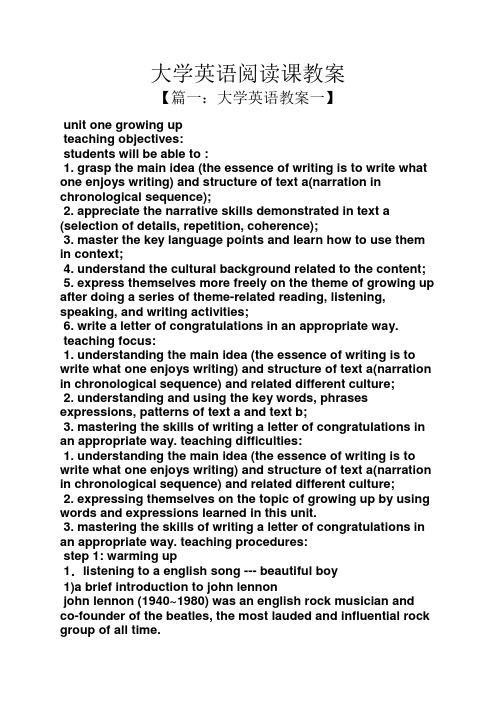
大学英语阅读课教案【篇一:大学英语教案一】unit one growing upteaching objectives:students will be able to :1. grasp the main idea (the essence of writing is to write what one enjoys writing) and structure of text a(narration in chronological sequence);2. appreciate the narrative skills demonstrated in text a (selection of details, repetition, coherence);3. master the key language points and learn how to use them in context;4. understand the cultural background related to the content;5. express themselves more freely on the theme of growing up after doing a series of theme-related reading, listening, speaking, and writing activities;6. write a letter of congratulations in an appropriate way.teaching focus:1. understanding the main idea (the essence of writing is to write what one enjoys writing) and structure of text a(narration in chronological sequence) and related different culture;2. understanding and using the key words, phrases expressions, patterns of text a and text b;3. mastering the skills of writing a letter of congratulations in an appropriate way. teaching difficulties:1. understanding the main idea (the essence of writing is to write what one enjoys writing) and structure of text a(narration in chronological sequence) and related different culture;2. expressing themselves on the topic of growing up by using words and expressions learned in this unit.3. mastering the skills of writing a letter of congratulations in an appropriate way. teaching procedures:step 1: warming up1.listening to a english song --- beautiful boy1)a brief introduction to john lennonjohn lennon (1940~1980) was an english rock musician andco-founder of the beatles, the most lauded and influential rock group of all time.2) listening to the english song--- beautiful boy3) ss finish after-listening practice on page34) questions about the song and the textsa. in your opinion, what is the song beautiful boy going to tell us?b. what does lennon think of growing up? is it easy or full of adventures?c. can you guess what the texts in this unit are going to be about?2. background information1) spaghettidefinition:spaghetti is the italian-style thin noodle, cooked by boiling and served with sauce. unlike some chinese noodles, it is not served in soup and will never taste pulpy (软乎乎、没有嚼劲的). listen and practice:read the words given below and then listen to the passage. after listening to the passage, one student is required to come up and show the right way of eating spaghetti before the class. the right way of eating spaghetti 1. hold the fork in your hand as if to poke the spaghetti. 2. scoop up a small amount of spaghetti on your fork and raise it about 30cm above your plate. 3. make sure the spaghetti on your fork is completely disconnected from the remainder on your plate.4. put the prongs of the fork at an edge of the plate that is free of food.5. quickly point the prongs of the fork straight down toward the plate and place the points onthe plate.6. twirl the fork to gather the spaghetti around the prongs.7. with a quick scooping movement, gather up the roll around the prongs and place it in yourmouth.8. gently gather up any stray spaghetti ends that don’t make it all the way into your mouth.2) the american educational systemin the united states, education is the responsibility of individual states, not of the federal government, so requirements may vary from one state to another. the following is a generalization:kindergarten: under 5 years oldelementary / primary school (grades 1~6): 6~11 yearsjunior high / middle school (grades 7~8): 12~13 yearssenior / high school (grades 9~12): 14~17 years oldcollege, institute, academy (学院), university3. explanation of the title of text ahave ss read the title of text a and find out in which paragraph a similar phrase appears (para.5). ask ss to explain in their own words what the author’s mean by ―write for myself‖. step 2: global analysis of text a1. scanningss scan text a and find out all the time words, phrases and clauses.since my childhood in belleville (para. 1)until my third year in high school (para. 1)until then (para. 1)when our class was assigned to mr. fleagle for third-year english (para. 2)late in the year (para. 3)until the night before the essay was due (para. 3)when i finished (para. 6)next morning (para. 6)two days passed (para. 6)when i saw him lift my paper from his desk ... (para. 6) when mr. fleagle finished (para. 9)2. part division of the textpart 1(paras 1-2) baker was bored by everything associated with english courses, including his new english teacher.part 2(paras 3-5)baker found himself attracted by one particular topic and wrote about it for his own enjoyment.part 3(paras 6-9)the experience of writing the essay helped baker discover his talent for writing and realize what he wished to do in life.3. further understanding1) exercise: true or falsea. baker had never thought of becoming a writer until he was in the eleventh grade. (f)b. teachers found it painful to read students’ long and lifeless essays. (t)c. before mr. fleagle became the english teacher for baker’s class, the english course had been interesting. (f)d. in baker’s opinion, mr. fleagle was really a formal, rigid and out-of-date teacher only because of fleagle’s manner of speaking. (f)2) exercise: multiple choice (all the exercises in teaching ppt)3) questions related to text a:ss answer the following questions orally and brieflya. do you think baker would write another essay if he had enough time? why?b. what was baker prepared for when he found all the papers had been given back but his?c. whose essay did mr. fleagle read to the class? how did the class respond?d. which paragraph in this part gives readers the impression that baker’s essay was very good?e. why did baker feel so delighted?step 3: language / culture study and practice1. explain language points and have ss practice themdifficult sentences1)2) paraphrase the sentence.(i found it painful to write long, boring essays as required by teachers; neither did teachers enjoy what i wrote.)3) what can we learn from this phrase?(we can know from this phrase that before mr. fleagle became baker’s english teacher, all english courses were dull.)4)what does the author really mean when he says ―i ... was not disappointed‖?(he means that his expectation was right that mr. fleag le’s lessons were dull.)5) 1) what can we infer from these sentences?(baker was unwilling to write his essay.)2) list phrases to support your inference.(did nothing until … the essay was due; faced up to the unwelcome task.)6) paraphrase the sentence and translate it into chinese.(at the sight of the title i saw an unusual series of pictures in my mind’s eye. 这个题目在我脑海里唤起了一连串不同寻常的图像。
大学英语优秀教案50篇
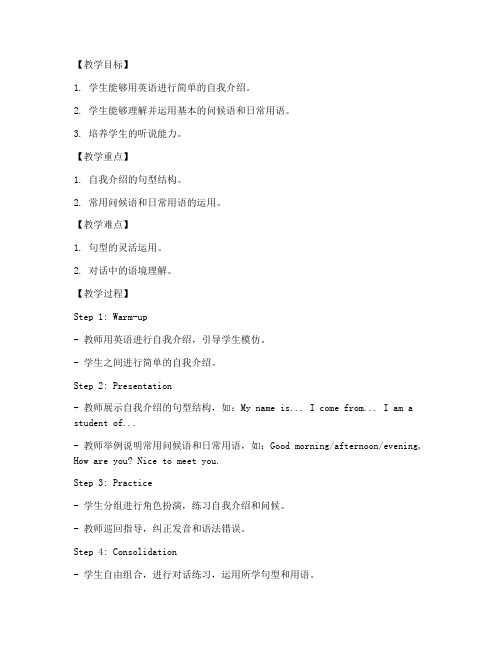
【教学目标】1. 学生能够用英语进行简单的自我介绍。
2. 学生能够理解并运用基本的问候语和日常用语。
3. 培养学生的听说能力。
【教学重点】1. 自我介绍的句型结构。
2. 常用问候语和日常用语的运用。
【教学难点】1. 句型的灵活运用。
2. 对话中的语境理解。
【教学过程】Step 1: Warm-up- 教师用英语进行自我介绍,引导学生模仿。
- 学生之间进行简单的自我介绍。
Step 2: Presentation- 教师展示自我介绍的句型结构,如:My name is... I come from... I am a student of...- 教师举例说明常用问候语和日常用语,如:Good morning/afternoon/evening, How are you? Nice to meet you.Step 3: Practice- 学生分组进行角色扮演,练习自我介绍和问候。
- 教师巡回指导,纠正发音和语法错误。
Step 4: Consolidation- 学生自由组合,进行对话练习,运用所学句型和用语。
- 教师选取优秀对话进行展示,给予点评。
Step 5: Homework- 学生回家后,用英语写一篇简短的自我介绍。
- 课后复习常用问候语和日常用语。
教案二:Unit 2 Daily Life【教学目标】1. 学生能够用英语描述日常生活。
2. 学生能够理解并运用与日常生活相关的词汇和句型。
3. 培养学生的听力和口语能力。
【教学重点】1. 描述日常生活的句型结构。
2. 与日常生活相关的词汇和句型。
【教学难点】1. 句型的灵活运用。
2. 对话中的语境理解。
【教学过程】Step 1: Warm-up- 教师提问学生关于日常生活的常见话题,如:What do you usually do in the morning? What is your favorite food?- 学生回答问题,复习相关词汇。
大学英语完整的教案

大学英语完整的教案【篇一:大学英语教案经典模板】教案practical college english新认知大学实用英语综合教程教研室:公共课部教师姓名:freefishwang【篇二:大学英语教案模板】unit 8 book 1 experiencing englishi. teaching objectives1. skills:1) reading: reading between the lines2) writing: how to use punctuations in a sentence3) listening: understanding the passages about love and friendship, listening for the main idea and the important details, learning to take notes while listening4) speaking: talking about love and friendship2. vocabulary development:w, depart, enclose, endure, identical, intense, occupy, provoke, standing, trim,2) expressions: compare… to, drift apart, ever after, even if/ though, join hands (with), no matter what/ how, etc., succeed in, try on, go by, in case, pass away, work out3. grammar and structure:1) adverbial clause2) attributive clause3) modal auxiliaries in subjunctive moodii. important points:leave nothing to chance, compare to, even if/ though, no matter how/ what, go by, work out, recognize as/ by, compare with/ toiii. difficult points:1.distinguishing replace, substitute, take the place of; confront, encounter, meet; bear, endure, put up with, stand, suffer, tolerate; acknowledge, admit, confess, recognize2. speaking: talking about love and friendship3. listening: understanding the passages, listening for the main idea and the important details, learning to take notes while listeningiv. teaching arrangements:1. total class time for this unit: 8 periods2. suggested arrangement:1) talking:(duty report, group discussion, free talk etc.) 402) pre-reading activities: 15-203) understanding the structure of text a: 15-204) detailed study of the language:1005) writing skills: 156) text summary 10’7) exercises: 558) reading skills: 15-259) detailed study of of text b: 60-7010) comprehensive exercises: 20iv. lecture scripts:(by the teachers)【篇三:新视野大学英语读写2(第三版)完整教案】新视野大学英语读写教程(第三版)book 2 教案。
大学英语完整的教案

大学英语完整的教案【篇一:大学英语教案经典模板】教案practical college english新认知大学实用英语综合教程教研室:公共课部教师姓名:freefishwang【篇二:大学英语教案模板】unit 8 book 1 experiencing englishi. teaching objectives1. skills:1) reading: reading between the lines2) writing: how to use punctuations in a sentence3) listening: understanding the passages about love and friendship, listening for the main idea and the important details, learning to take notes while listening4) speaking: talking about love and friendship2. vocabulary development:w, depart, enclose, endure, identical, intense, occupy, provoke, standing, trim,2) expressions: compare… to, drift apart, ever after, even if/ though, join hands (with), no matter what/ how, etc., succeed in, try on, go by, in case, pass away, work out3. grammar and structure:1) adverbial clause2) attributive clause3) modal auxiliaries in subjunctive moodii. important points:leave nothing to chance, compare to, even if/ though, no matter how/ what, go by, work out, recognize as/ by, compare with/ toiii. difficult points:1.distinguishing replace, substitute, take the place of; confront, encounter, meet; bear, endure, put up with, stand, suffer, tolerate; acknowledge, admit, confess, recognize2. speaking: talking about love and friendship3. listening: understanding the passages, listening for the main idea and the important details, learning to take notes while listeningiv. teaching arrangements:1. total class time for this unit: 8 periods2. suggested arrangement:1) talking:(duty report, group discussion, free talk etc.) 402) pre-reading activities: 15-203) understanding the structure of text a: 15-204) detailed study of the language:1005) writing skills: 156) text summary 10’7) exercises: 558) reading skills: 15-259) detailed study of of text b: 60-7010) comprehensive exercises: 20iv. lecture scripts:(by the teachers)【篇三:新视野大学英语读写2(第三版)完整教案】新视野大学英语读写教程(第三版)book 2 教案。
大学英语教案范文

大学英语教案范文大学英语教案范文篇一:大学英语教案模板天津大学仁爱学院英语教学部教案20 11 -20 12 学年第二学期授课部门:英语教学部授课教师:Young大学英语教案范文篇二:大学英语教案授课教师:钟雪珂授课时间:2014年3月29日全天、3月30日全天授课科目:新英语(第1册)一、授课内容及目标(一)授课内容1. 自我介绍和日常生活中常见英语标识2. 教材内容:主要包括三个方面的内容。
第一,教材中Unit1、6、7、9的课文内容;第二,相关单元的语法点,主要包括人称代词及其相关形式(主格、宾格、形容词性物主代词、名词性物主代词、反身代词)、动词过去式、被动形式;第三,写作,主要介绍中英文书信格式的差异。
(二)目标:通过授课,让学生熟悉相关单元的知识点(单词、短语、句型和语法点)。
此外,让学生了解中英文书信格式的差异,熟悉几种书信类型的常用表达。
二、教学重点和难点(一)重点:教材中相关单元的知识点1. 单词:Unit1中的introduce/tip/enter/confident/contact/nickname/host/enjoy;Unit 6中的problem/difficulty/order/experience/restaurant/pleasant;Unit7中的purpose/aim/consideration/simply/complete/suit/bargain;Unit 9中的tip/ waiter/ barber/ wage/ earn/ decent/ absolute/ vary/ customs。
2. 短语和句型:Unit1 中的introduce oneself/ have…in common/ lead to/ have a good time/ It is +形容词+ to do sth.;Unit 6 中的have difficulty in doing sth./ask for/have a holiday; Unit 7中的go shopping/ in advance/ be based on/ make up one’s mind/ try on/face with;Unit 9 中的make up/ earn a living。
大学英语教案模板全英文版(10篇)

大学英语教案模板全英文版(优秀10篇)英语(英语:English)是一种西日耳曼语支,最早被中世纪的英国使用,并因其广阔的殖民地而成为世界使用面积最广的语言。
下面是我辛苦为朋友们带来的10篇《大学英语教案模板全英文版》,希望可以启发、帮助到大朋友、小朋友们。
标准英语教案篇五英语教案篇八一。
教学资料《新课程标准小学英语》book7 leon5 how do you usually go to school?二。
学生分析六年级的学生大胆且自立,好奇心重求知欲强,并且爱表现自我。
在经过一段时光的师生磨合和配合之后,进入第五课学习时,学生们就基本熟悉了教师的课堂英语。
爱玩是孩子的天性,六年级的学生不喜欢机械重复乏味的课堂,他们喜欢在游戏中学习,所以在教学过程中我采用了情景教学和游戏教学的模式,让学生们积极主动地参与到英语学习中。
六年级的学生注意力能够集中的时光比较短,借助多媒体手段等激励方式,使学生集中注意力在学习上。
六年级的学生喜欢自我表现,采用小组合作的方式完成情景教学,使学生体味团队协作取得成功的喜悦,增强他们学习英语的自信心。
三。
教学目标1、知识目标a.使学生能熟记bus,car,train,on foot新词汇b.使学生能熟记用句子how do you usually go to school?i usually go to school by…?进行对话2、本事目标使学生能把学到的知识运用到实际生活中去3、情感目标培养学生的自我表达本事和团队合作精神四。
教学重点与难点1、熟记所学新单词,做到发音准确,拼写正确2、能过把新单词运用到句型i usually go to school by……?五。
教学方法情景教学法与游戏教学法相结合六。
学习方法自主学习与小组合作相结合七。
课前准备单词卡片、短语卡片、幻灯片等八。
教学过程1、新课导入首先全班同学起立合唱leon3中的歌曲where do you e from?吸引学生注意力到课堂学习中,同时营造一个良好的英语学习氛围,为新课学习做准备。
大学英语教案模板范文.doc

大学英语教案模板范文【篇一:大学英语教案模板】天津大学仁爱学院英语教学部教案20 11 -20 12 学年第二学期授课部门:英语教学部授课教师:young【篇二:大学英语教案模板】unit 8 book 1 experiencing english i. teachingobjectives1. skills:1) reading: reading between the lines2) writing: how to use punctuations in a sentence3) listening: understanding the passages about love and friendship, listening for the main idea and the important details, learning to take notes while listening4) speaking: talking about love and friendship2. vocabulary development:1) words: acquaintance, barely, encounter, incline, intimate, occasional, principle, recall, recognize, replace, summarize,upset, bow, depart, enclose, endure, identical, intense, occupy, provoke, standing, trim,2) exp ressions: compare ⋯to, drift apart, ever after, even if/ though, join hands (with), no matter what/ how, etc., succeedin, try on, go by, in case, pass away, work out3. grammar and structure:1) adverbial clause 2)attributive clause3) modal auxiliaries in subjunctive moodii. important points:iii. difficult points:1.distinguishing replace, substitute, take the place of;confront, encounter, meet; bear, endure, put up with, stand,suffer, tolerate; acknowledge, admit, confess, recognize2. speaking: talking about love and friendship3. listening: understanding the passages, listening for themain idea and the important details, learning to take noteswhile listeningiv. teaching arrangements:1. total class time for this unit: 8 periods2. suggested arrangement:1) talking:(duty report, group discussion, free talk etc.) 402) pre-reading activities: 15-203) understanding the structure of text a: 15-204) detailed study of the language:1005) writing skills: 156) text summary 10 ’ 7)exercises: 558) reading skills: 15-259) detailed study of of text b: 60-7010) comprehensive exercises: 20iv. lecture scripts:(by the teachers)【篇三:大学英语friendship 教案模板】teaching plan for friendship -all the cabbie had was a letter班级:2 英语13-1姓名:梁欢学号:201341908105 teaching aimsand demands :1. get more background information on the article.2. learning knowledge about the type of the writing and thestructure .3. the comprehension of the text .4. the mastery of the vocabulary and the language points .5. the familiarization with the language and the writingtechniques .teaching content :1. learning all the cabbie had was a letter .2. keys to the meaning of friendship .3.listening comprehension. important points :1.analysis of the structure of the text.2.students can read and understand the article, in the processof reading to consolidate and improve the students readingskills and the ability to extract important information.3.the cultivation of students effective reading skimming andreading skills and strategies. difficult points: 1.the difficultiesare letting the students grasp the type of writing feature article .2.identifying figures of speech .3.paraphrasing some complex sentences .4. translating some sentences .6.employing sentences variety for special effects . teaching period: period 1-2i.warm-up questions / activities listen to the recording two or three times and then think over the following questions:1. have you ever heard of dionne warwick? have you happened to hear her sing?2. what does a fair weather friend mean?3. what does dionne warwick think friends are for?4. does the song give you any idea of what the stories in this unit will be about?ii.teaching schedule. step 1lead-in listening task1. listening practice - here is a story about two friends. listen carefully and see what it reveals .2. after listening - complete the following statements according to what you have heard . step 2 reading taskread the article and skim for the main idea of this article .part one (1-20) from a conversation with the cab driver the author learned how much he regretted failing to keep up corre- spondence with his old friends ed .part two (21-35) reading the letter by himself , the author learned more about the lifelong friendship between the driver and old ed .part three (30) the drivers experience urged the author to reach for his pen .step 3 detailed reading1.pair work-one of you ask the questions and the other answers.2.do the exercises and then compare your answers with a partner .3.read aloud paragraphs 6 to 15 until you have learned then by heart. then try to complete the passage from memory .4.think of these questions . what does a cabbie do?who wrote the letter to the cabbie?why was all the cabbie had only a letter?5.read the last sentence and try to guess what the story isabout.6.summarize the story with three sentences?period 3-4iii useful expressions1.be lost in / lose oneself in: be absorbed in; be fully occupied with .2.or something: used when you are not very sure about what you have just said . 3.go ahead: continue; begin (sometimes followed by with + n.)4.estimate: vt. form a judgment about (a quantity or value)n. approximate calculation or judgment made about a quantity orvalue.5.might / may (just) as well: if you say that you might / may(just) as well do sth., you mean that you will do it although youdo not have a strong desire to do it and may even feel slightlyreluctant about it.6.not much of: not a good ⋯7.keep up: continue without stopping .iv summaryfrom a conversation with the cab driver the author learnedhow much he regretted failing to keep up corre-spondencewith his old friends ed .reading the letter by himself , the author learned more aboutthe lifelong friendship between the driver and old ed .thedrivers experience urged the author to reach for his pen .v homeworkwrite a letter to one of your friend . vi .feedback。
大学英语口语课教案怎么写
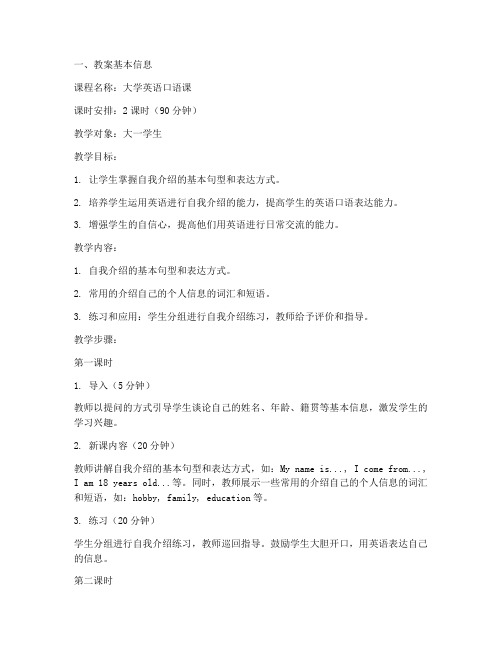
一、教案基本信息课程名称:大学英语口语课课时安排:2课时(90分钟)教学对象:大一学生教学目标:1. 让学生掌握自我介绍的基本句型和表达方式。
2. 培养学生运用英语进行自我介绍的能力,提高学生的英语口语表达能力。
3. 增强学生的自信心,提高他们用英语进行日常交流的能力。
教学内容:1. 自我介绍的基本句型和表达方式。
2. 常用的介绍自己的个人信息的词汇和短语。
3. 练习和应用:学生分组进行自我介绍练习,教师给予评价和指导。
教学步骤:第一课时1. 导入(5分钟)教师以提问的方式引导学生谈论自己的姓名、年龄、籍贯等基本信息,激发学生的学习兴趣。
2. 新课内容(20分钟)教师讲解自我介绍的基本句型和表达方式,如:My name is..., I come from..., I am 18 years old...等。
同时,教师展示一些常用的介绍自己的个人信息的词汇和短语,如:hobby, family, education等。
3. 练习(20分钟)学生分组进行自我介绍练习,教师巡回指导。
鼓励学生大胆开口,用英语表达自己的信息。
第二课时1. 复习(5分钟)教师通过提问方式复习上节课的内容,检查学生掌握情况。
2. 实践(20分钟)学生分组进行自我介绍练习,教师给予评价和指导。
鼓励学生互相纠正发音和表达方式,提高口语表达能力。
3. 总结与作业(15分钟)教师总结本节课的主要内容和收获,布置作业:让学生写一篇关于自己的人物介绍短文,要求使用本节课学到的句型和词汇。
教学评价:1. 教师通过课堂观察、练习点评等方式评价学生的口语表达能力。
2. 学生互相评价,提高自我纠正能力。
3. 作业完成情况:检查学生对课堂内容的掌握程度。
通过本的教案设计,教师可以有效地帮助学生掌握自我介绍的基本句型和表达方式,提高学生的英语口语表达能力。
同时,学生能够在实践中增强自信心,为今后的英语学习打下坚实基础。
大学英文教案设计万能模板
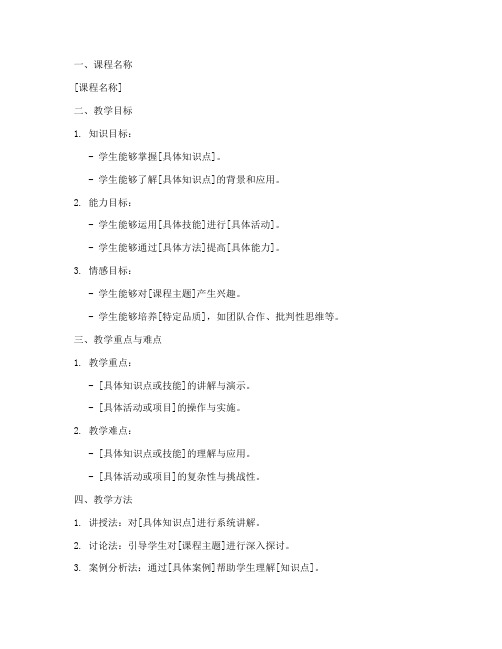
一、课程名称[课程名称]二、教学目标1. 知识目标:- 学生能够掌握[具体知识点]。
- 学生能够了解[具体知识点]的背景和应用。
2. 能力目标:- 学生能够运用[具体技能]进行[具体活动]。
- 学生能够通过[具体方法]提高[具体能力]。
3. 情感目标:- 学生能够对[课程主题]产生兴趣。
- 学生能够培养[特定品质],如团队合作、批判性思维等。
三、教学重点与难点1. 教学重点:- [具体知识点或技能]的讲解与演示。
- [具体活动或项目]的操作与实施。
2. 教学难点:- [具体知识点或技能]的理解与应用。
- [具体活动或项目]的复杂性与挑战性。
四、教学方法1. 讲授法:对[具体知识点]进行系统讲解。
2. 讨论法:引导学生对[课程主题]进行深入探讨。
3. 案例分析法:通过[具体案例]帮助学生理解[知识点]。
4. 角色扮演法:让学生在模拟环境中体验[特定情境]。
5. 实践操作法:通过[具体活动]让学生动手实践,提高技能。
五、教学过程1. 导入- 引入话题:简要介绍[课程主题]的背景和重要性。
- 引起兴趣:提出与[课程主题]相关的问题,激发学生的好奇心。
2. 讲解- 讲解[具体知识点]:详细讲解[知识点],结合实例说明。
- 展示[具体技能]:演示[技能]的操作步骤,讲解技巧和注意事项。
3. 讨论- 引导学生就[课程主题]展开讨论,分享观点和经验。
- 鼓励学生提出问题,共同解决问题。
4. 案例分析- 分析[具体案例],引导学生从中提炼[知识点]。
- 讨论案例中的决策过程和结果,培养学生的批判性思维。
5. 角色扮演- 分组进行角色扮演,让学生在模拟环境中体验[特定情境]。
- 引导学生分析角色扮演中的问题,并提出解决方案。
6. 实践操作- 学生分组进行[具体活动],动手实践,提高技能。
- 教师巡回指导,解答学生在操作过程中遇到的问题。
7. 总结- 总结[课程主题]的主要内容,强调重点和难点。
- 引导学生反思学习过程,提出改进意见。
大学英语全英教案模板及范文
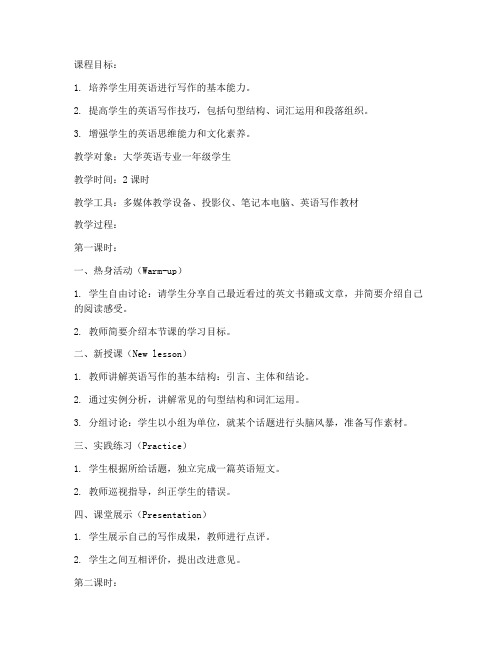
课程目标:1. 培养学生用英语进行写作的基本能力。
2. 提高学生的英语写作技巧,包括句型结构、词汇运用和段落组织。
3. 增强学生的英语思维能力和文化素养。
教学对象:大学英语专业一年级学生教学时间:2课时教学工具:多媒体教学设备、投影仪、笔记本电脑、英语写作教材教学过程:第一课时:一、热身活动(Warm-up)1. 学生自由讨论:请学生分享自己最近看过的英文书籍或文章,并简要介绍自己的阅读感受。
2. 教师简要介绍本节课的学习目标。
二、新授课(New lesson)1. 教师讲解英语写作的基本结构:引言、主体和结论。
2. 通过实例分析,讲解常见的句型结构和词汇运用。
3. 分组讨论:学生以小组为单位,就某个话题进行头脑风暴,准备写作素材。
三、实践练习(Practice)1. 学生根据所给话题,独立完成一篇英语短文。
2. 教师巡视指导,纠正学生的错误。
四、课堂展示(Presentation)1. 学生展示自己的写作成果,教师进行点评。
2. 学生之间互相评价,提出改进意见。
第二课时:一、复习上节课内容(Review)1. 教师简要回顾上节课的学习内容。
2. 学生分享自己在写作过程中遇到的问题及解决方法。
二、巩固练习(Consolidation)1. 教师提供一篇英语短文,要求学生根据文章内容进行改写或续写。
2. 学生独立完成改写或续写任务。
三、课堂展示(Presentation)1. 学生展示自己的改写或续写成果,教师进行点评。
2. 学生之间互相评价,提出改进意见。
四、总结与反馈(Summary and feedback)1. 教师对本节课的学习情况进行总结。
2. 学生分享自己在学习过程中的收获与不足。
3. 教师针对学生的反馈,提出改进建议。
教学反思:本节课通过讲解英语写作的基本结构和技巧,帮助学生掌握了英语写作的基本方法。
在实践练习环节,学生能够运用所学知识进行写作,并在课堂展示中展示自己的成果。
但在课堂展示环节,部分学生表达不够流畅,需要进一步提高口语表达能力。
大学英语口语教案10篇

大学英语口语教案10篇第一篇:自我介绍目标:学会用简单的英语介绍自己教学内容:- 自我介绍的基本要素,如姓名,年龄,职业等- 介绍自己的家庭、兴趣爱好和个人特点- 练口语表达自我介绍第二篇:日常生活用语目标:掌握常用的日常生活用语教学内容:- 问候用语,如"Hello","How are you?"等- 谈论天气和季节- 讨论日常活动和惯第三篇:餐厅用餐目标:学会在餐厅用英语点餐和交流教学内容:- 餐厅用语,如"Can I have a menu?","I'd like to order"等- 研究点菜和询问食物的口味偏好- 练用英语与服务员交流第四篇:购物对话目标:学会在购物场景中用英语交流教学内容:- 商店常用语,如"Can I help you?","How much does it cost?"等- 研究询问商品信息和购买需求- 练用英语与销售员进行购物对话第五篇:约会对话目标:学会用英语进行约会对话教学内容:- 约会用语,如"Would you like to go out with me?","What time shall we meet?"等- 研究邀请和接受约会邀请的表达方式- 练用英语进行约会场景对话第六篇:旅游对话目标:学会在旅游场景中用英语进行交流教学内容:- 研究询问旅游信息和导航指引- 练用英语在旅游场景中进行对话第七篇:工作面试目标:学会用英语进行工作面试对话教学内容:- 工作面试用语,如"Tell me about yourself","What are your strengths and weaknesses?"等- 研究回答常见的面试问题- 练用英语进行工作面试对话第八篇:建议和意见目标:学会用英语提出和接受建议和意见教学内容:- 表达建议和意见的常用词汇和短语- 研究如何提出和接受他人的建议和意见- 练用英语进行建议和意见对话第九篇:谈论喜好目标:学会用英语谈论自己的喜好教学内容:- 谈论喜欢的事物、电影、音乐等- 研究询问他人的喜好和兴趣- 练用英语进行关于喜好的对话第十篇:情景对话目标:综合运用口语进行情景对话教学内容:- 综合运用前九篇所学知识进行情景对话- 提供不同情景的练材料,如旅行、购物、工作等- 练用英语进行综合情景对话。
大学英语优秀教案
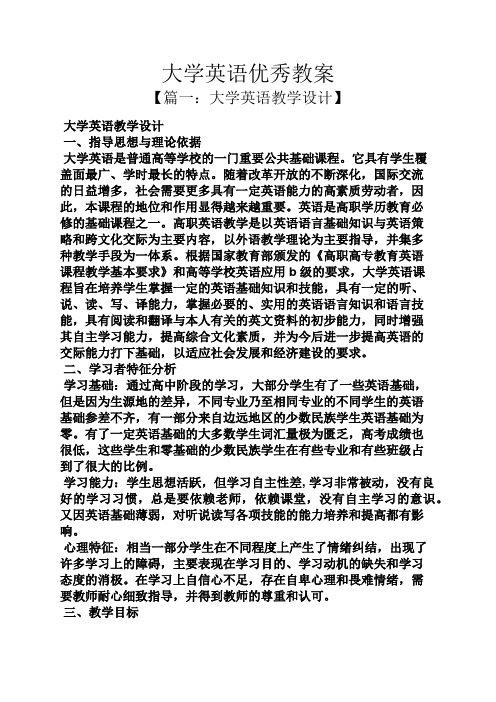
大学英语优秀教案【篇一:大学英语教学设计】大学英语教学设计一、指导思想与理论依据大学英语是普通高等学校的一门重要公共基础课程。
它具有学生覆盖面最广、学时最长的特点。
随着改革开放的不断深化,国际交流的日益增多,社会需要更多具有一定英语能力的高素质劳动者,因此,本课程的地位和作用显得越来越重要。
英语是高职学历教育必修的基础课程之一。
高职英语教学是以英语语言基础知识与英语策略和跨文化交际为主要内容,以外语教学理论为主要指导,并集多种教学手段为一体系。
根据国家教育部颁发的《高职高专教育英语课程教学基本要求》和高等学校英语应用b级的要求,大学英语课程旨在培养学生掌握一定的英语基础知识和技能,具有一定的听、说、读、写、译能力,掌握必要的、实用的英语语言知识和语言技能,具有阅读和翻译与本人有关的英文资料的初步能力,同时增强其自主学习能力,提高综合文化素质,并为今后进一步提高英语的交际能力打下基础,以适应社会发展和经济建设的要求。
二、学习者特征分析学习基础:通过高中阶段的学习,大部分学生有了一些英语基础,但是因为生源地的差异,不同专业乃至相同专业的不同学生的英语基础参差不齐,有一部分来自边远地区的少数民族学生英语基础为零。
有了一定英语基础的大多数学生词汇量极为匮乏,高考成绩也很低,这些学生和零基础的少数民族学生在有些专业和有些班级占到了很大的比例。
学习能力:学生思想活跃,但学习自主性差, 学习非常被动,没有良好的学习习惯,总是要依赖老师,依赖课堂,没有自主学习的意识。
又因英语基础薄弱,对听说读写各项技能的能力培养和提高都有影响。
心理特征:相当一部分学生在不同程度上产生了情绪纠结,出现了许多学习上的障碍,主要表现在学习目的、学习动机的缺失和学习态度的消极。
在学习上自信心不足,存在自卑心理和畏难情绪,需要教师耐心细致指导,并得到教师的尊重和认可。
三、教学目标知识目标:本课程教学既要培养学生具备必要的英语语言基础知识,具有较强的阅读能力和一定的听、说、读、写、译能力,使他们能用英语交流信息,能借助词典阅读和翻译有关英语业务资料,也应重视培养学生运用英语进行有关涉外业务工作的能力,在涉外交际的日常活动和业务活动中进行简单的口头和书面交流。
大学生英语教案怎么写
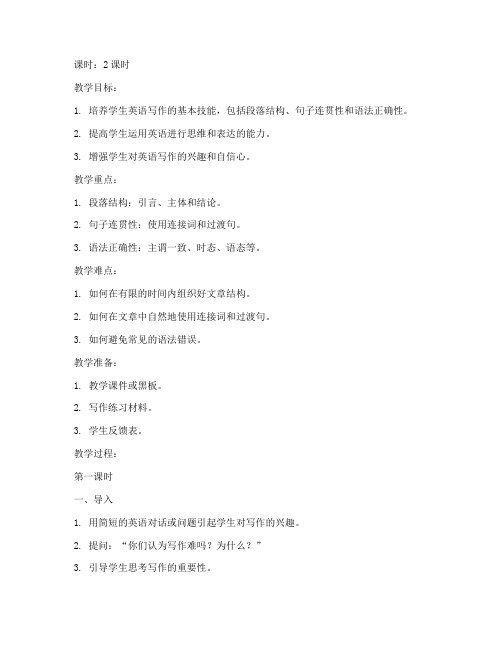
课时:2课时教学目标:1. 培养学生英语写作的基本技能,包括段落结构、句子连贯性和语法正确性。
2. 提高学生运用英语进行思维和表达的能力。
3. 增强学生对英语写作的兴趣和自信心。
教学重点:1. 段落结构:引言、主体和结论。
2. 句子连贯性:使用连接词和过渡句。
3. 语法正确性:主谓一致、时态、语态等。
教学难点:1. 如何在有限的时间内组织好文章结构。
2. 如何在文章中自然地使用连接词和过渡句。
3. 如何避免常见的语法错误。
教学准备:1. 教学课件或黑板。
2. 写作练习材料。
3. 学生反馈表。
教学过程:第一课时一、导入1. 用简短的英语对话或问题引起学生对写作的兴趣。
2. 提问:“你们认为写作难吗?为什么?”3. 引导学生思考写作的重要性。
二、讲解段落结构1. 讲解引言、主体和结论的基本概念。
2. 举例说明如何撰写引言、主体和结论。
3. 让学生尝试撰写一段短文,运用所学的段落结构。
三、句子连贯性训练1. 讲解连接词和过渡句的作用。
2. 举例说明如何使用连接词和过渡句使文章更加连贯。
3. 让学生进行句子连贯性练习。
四、语法讲解与练习1. 讲解主谓一致、时态、语态等语法知识。
2. 让学生进行语法练习,巩固所学知识。
五、课堂小结1. 总结本节课的重点内容。
2. 布置课后作业。
第二课时一、复习1. 回顾上一节课的内容,检查学生对段落结构、句子连贯性和语法知识的掌握情况。
2. 让学生进行课堂练习,巩固所学知识。
二、写作指导1. 讲解如何组织文章结构,给出一些写作技巧。
2. 让学生根据所学知识,尝试撰写一篇短文。
三、学生互评1. 将学生分成小组,让他们互相批改对方的作文。
2. 引导学生关注文章的结构、连贯性和语法错误。
四、教师点评1. 教师选取几篇学生作文进行点评,指出优点和不足。
2. 针对学生的不足,给出改进建议。
五、课堂小结1. 总结本节课的重点内容。
2. 布置课后作业。
教学反思:1. 教师应关注学生的个体差异,针对不同层次的学生给予不同的指导。
大学外语备课教案怎么写
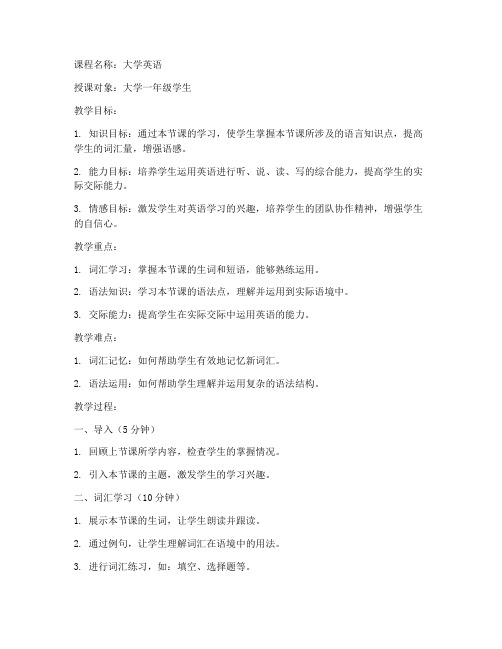
课程名称:大学英语授课对象:大学一年级学生教学目标:1. 知识目标:通过本节课的学习,使学生掌握本节课所涉及的语言知识点,提高学生的词汇量,增强语感。
2. 能力目标:培养学生运用英语进行听、说、读、写的综合能力,提高学生的实际交际能力。
3. 情感目标:激发学生对英语学习的兴趣,培养学生的团队协作精神,增强学生的自信心。
教学重点:1. 词汇学习:掌握本节课的生词和短语,能够熟练运用。
2. 语法知识:学习本节课的语法点,理解并运用到实际语境中。
3. 交际能力:提高学生在实际交际中运用英语的能力。
教学难点:1. 词汇记忆:如何帮助学生有效地记忆新词汇。
2. 语法运用:如何帮助学生理解并运用复杂的语法结构。
教学过程:一、导入(5分钟)1. 回顾上节课所学内容,检查学生的掌握情况。
2. 引入本节课的主题,激发学生的学习兴趣。
二、词汇学习(10分钟)1. 展示本节课的生词,让学生朗读并跟读。
2. 通过例句,让学生理解词汇在语境中的用法。
3. 进行词汇练习,如:填空、选择题等。
三、语法讲解(10分钟)1. 讲解本节课的语法点,结合例句进行讲解。
2. 让学生进行语法练习,巩固所学知识。
四、听力训练(15分钟)1. 播放听力材料,让学生完成听力任务。
2. 对听力材料进行分析,讲解难点。
五、口语练习(15分钟)1. 设计口语练习题,如:角色扮演、情景对话等。
2. 学生分组进行口语练习,教师巡回指导。
六、阅读理解(15分钟)1. 阅读课文,了解文章大意。
2. 进行阅读理解练习,如:选择题、填空题等。
3. 对阅读材料进行分析,讲解难点。
七、写作训练(10分钟)1. 根据本节课的主题,布置写作任务。
2. 学生进行写作练习,教师巡回指导。
八、总结与反馈(5分钟)1. 总结本节课的学习内容,强调重点和难点。
2. 收集学生的反馈意见,为下一节课做好准备。
教学评价:1. 课堂表现:观察学生在课堂上的参与度、发言积极性等。
2. 作业完成情况:检查学生的课后作业,了解学生对本节课内容的掌握程度。
公开课教案大学英语怎么写
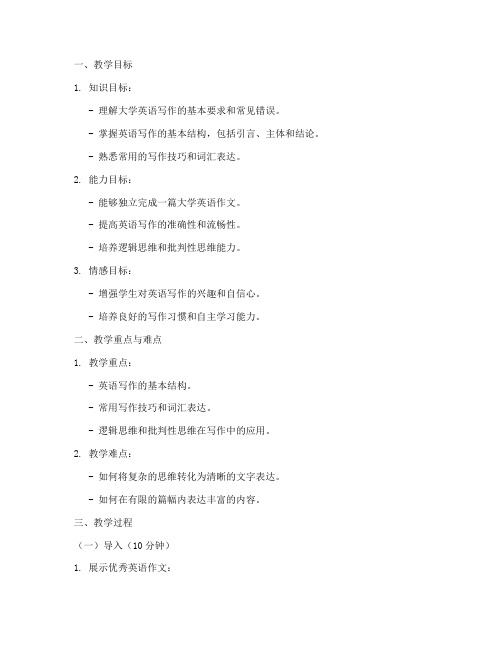
一、教学目标1. 知识目标:- 理解大学英语写作的基本要求和常见错误。
- 掌握英语写作的基本结构,包括引言、主体和结论。
- 熟悉常用的写作技巧和词汇表达。
2. 能力目标:- 能够独立完成一篇大学英语作文。
- 提高英语写作的准确性和流畅性。
- 培养逻辑思维和批判性思维能力。
3. 情感目标:- 增强学生对英语写作的兴趣和自信心。
- 培养良好的写作习惯和自主学习能力。
二、教学重点与难点1. 教学重点:- 英语写作的基本结构。
- 常用写作技巧和词汇表达。
- 逻辑思维和批判性思维在写作中的应用。
2. 教学难点:- 如何将复杂的思维转化为清晰的文字表达。
- 如何在有限的篇幅内表达丰富的内容。
三、教学过程(一)导入(10分钟)1. 展示优秀英语作文:- 通过展示优秀英语作文,激发学生的学习兴趣,并引出写作话题。
2. 讨论写作话题:- 提出与写作话题相关的问题,引导学生进行思考和讨论。
(二)写作技巧讲解(20分钟)1. 英语写作基本结构:- 引入、展开、总结的结构。
2. 常用写作技巧:- 如何开头和结尾。
- 如何使用过渡词和过渡句。
- 如何运用举例、对比、类比等修辞手法。
3. 词汇表达:- 介绍一些常用的写作词汇和短语。
(三)写作练习(30分钟)1. 分组讨论:- 将学生分成小组,讨论如何根据所学技巧完成写作。
2. 写作指导:- 教师针对学生的写作进行个别指导。
(四)展示与评价(20分钟)1. 学生展示:- 邀请部分学生展示自己的写作作品。
2. 教师评价:- 对学生的写作进行评价,指出优点和不足。
3. 学生互评:- 学生之间互相评价,提出改进建议。
四、课后作业1. 巩固练习:- 完成一篇与课堂话题相关的英语作文。
2. 自主阅读:- 阅读一些优秀的英语作文,学习其中的写作技巧。
五、教学反思1. 教学效果评估:- 通过课后作业和学生的反馈,评估教学效果。
2. 教学改进:- 根据学生的需求和反馈,调整教学内容和方法。
大学英语教案怎么写模板
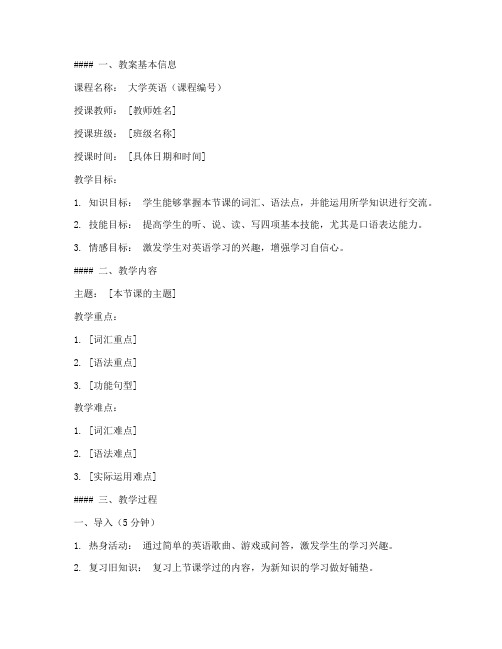
#### 一、教案基本信息课程名称:大学英语(课程编号)授课教师: [教师姓名]授课班级: [班级名称]授课时间: [具体日期和时间]教学目标:1. 知识目标:学生能够掌握本节课的词汇、语法点,并能运用所学知识进行交流。
2. 技能目标:提高学生的听、说、读、写四项基本技能,尤其是口语表达能力。
3. 情感目标:激发学生对英语学习的兴趣,增强学习自信心。
#### 二、教学内容主题: [本节课的主题]教学重点:1. [词汇重点]2. [语法重点]3. [功能句型]教学难点:1. [词汇难点]2. [语法难点]3. [实际运用难点]#### 三、教学过程一、导入(5分钟)1. 热身活动:通过简单的英语歌曲、游戏或问答,激发学生的学习兴趣。
2. 复习旧知识:复习上节课学过的内容,为新知识的学习做好铺垫。
二、新课讲解(20分钟)1. 词汇学习:介绍本节课的词汇,包括发音、拼写和例句。
2. 语法讲解:讲解本节课的语法点,结合例句进行讲解。
3. 功能句型:学习并练习本节课的功能句型。
三、实践环节(15分钟)1. 小组讨论:将学生分成小组,就本节课的主题进行讨论。
2. 角色扮演:让学生进行角色扮演,运用所学知识进行对话。
3. 听写练习:进行听写练习,检验学生对词汇和句型的掌握情况。
四、巩固与总结(10分钟)1. 复习本节课的重点内容:通过提问或讲解的方式,帮助学生巩固所学知识。
2. 总结:对本节课的学习内容进行总结,强调重点和难点。
#### 四、教学资源1. 教材: [教材名称及版本]2. 多媒体: [PPT、视频、音频等]3. 辅助材料: [单词卡片、语法练习册等]#### 五、教学反思教学效果:1. 学生对词汇和语法点的掌握程度。
2. 学生在实践环节的表现。
3. 学生对英语学习的兴趣和自信心。
改进措施:1. 针对学生在学习过程中遇到的问题,调整教学方法和策略。
2. 丰富教学资源,提高课堂趣味性。
3. 加强对学生口语表达能力的培养。
大学简短英语教案怎么写
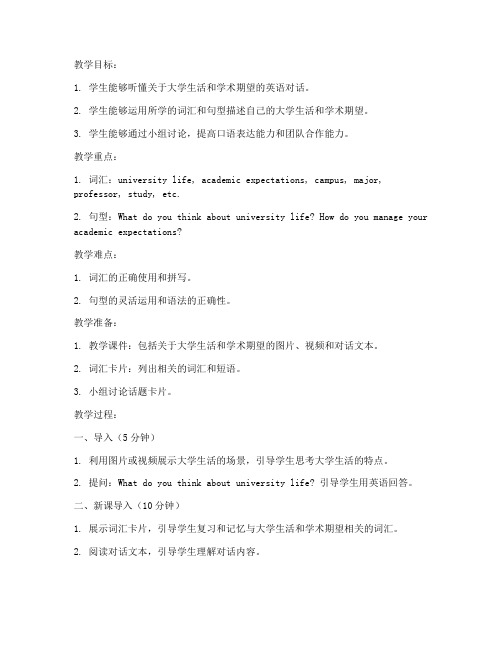
教学目标:1. 学生能够听懂关于大学生活和学术期望的英语对话。
2. 学生能够运用所学的词汇和句型描述自己的大学生活和学术期望。
3. 学生能够通过小组讨论,提高口语表达能力和团队合作能力。
教学重点:1. 词汇:university life, academic expectations, campus, major, professor, study, etc.2. 句型:What do you think about university life? How do you manage your academic expectations?教学难点:1. 词汇的正确使用和拼写。
2. 句型的灵活运用和语法的正确性。
教学准备:1. 教学课件:包括关于大学生活和学术期望的图片、视频和对话文本。
2. 词汇卡片:列出相关的词汇和短语。
3. 小组讨论话题卡片。
教学过程:一、导入(5分钟)1. 利用图片或视频展示大学生活的场景,引导学生思考大学生活的特点。
2. 提问:What do you think about university life? 引导学生用英语回答。
二、新课导入(10分钟)1. 展示词汇卡片,引导学生复习和记忆与大学生活和学术期望相关的词汇。
2. 阅读对话文本,引导学生理解对话内容。
3. 提问:What are the main points of the conversation? 引导学生总结对话要点。
三、词汇和句型学习(15分钟)1. 逐句讲解对话中的重点词汇和句型,如:“What do you think about university life?”2. 学生跟读并模仿,巩固词汇和句型的发音和语调。
3. 学生分组练习,运用所学的词汇和句型进行对话。
四、小组讨论(20分钟)1. 分发小组讨论话题卡片,每个小组选择一个话题进行讨论。
2. 学生运用所学的词汇和句型,描述自己的大学生活和学术期望。
- 1、下载文档前请自行甄别文档内容的完整性,平台不提供额外的编辑、内容补充、找答案等附加服务。
- 2、"仅部分预览"的文档,不可在线预览部分如存在完整性等问题,可反馈申请退款(可完整预览的文档不适用该条件!)。
- 3、如文档侵犯您的权益,请联系客服反馈,我们会尽快为您处理(人工客服工作时间:9:00-18:30)。
大学英语教案怎么写篇一:大学英语范本全新版《大学英语》课程名称:大学英语(一级)专业:本校05普通本科年级: 2005 学年: 2005-2006 学期:第一学期任课教师:全新版《大学英语》板块任课教师 Course Schedule Aims: 1. Developing Ss’ability of independent learning to be automatic learners. 2. Enhancing Ss’ability in using English: improving Ss’five micro-skills—listening, speaking, reading, writing, translation —especially listening and speaking so that they can communicate in spoken and written English. Required course materials: 1. College English (Book 1) —Integrated Curse, Listening and Speaking Course, Reading Course Note: Reading Course book is used as Ss’ self-access material. 2. One Dictionary: Teaching and Learning: 1. Keep in mind that it is YOU who have to study to improve your English. If you do not study by yourself, there is no use in coming to class. In other words, just listening to the teacher and other students in class does not help you improve your English. 2. Be well prepared when you come to class. It is of great importance for you to preview the course materials before class according to the course schedule. If not, you’ll find it very difficult to follow the class. 3. Class participation is vital. You should actively join in pair work or group discussion and do oral presentation before class. 4. It is important to turn in any assignments by the due date. If you know that you have a circumstance which will makes it impossible for you to turn in your assignment by the due date, you can and should come to consult with me about your problem beforehand. 5. Your essays should be done in a loose-leaf notebook so as to hand in your assignments by a loose paper.6. Since attendance/absence is part of evaluation, keep in mind that your absence will reduce your evaluation. Useful English Learning Resources: Magazines: English Language Learning, College English, English Salon, English Weekly, The world of English, English Digest, Overseas English Newspaper: 21st Century, China Daily Websites: (英语比萨园地); (听力快车); (普特英语听力); (英文写作网); (旺旺英语); .cn (中国日报);(华盛顿邮报) Unit 1 Writing For Myself 1. 教学目标及基本要求: Objectives: Students will be able to: 1) grasp the main idea (the essence of writing is to write what one enjoys writing) and structureof the text (narration in chronological sequence); 2) appreciate the narrative skills demonstrated in the text (selection of details, repetition and the use of synonyms.) 3) master the key language points and grammatical structures in the text; 4) conduct a series of reading, listening, speaking and writing activities related to the theme of the unit. 2. 教学内容及学时分配: Time allotment: 1st period: pre-reading; text organization nd2 period: while-reading 3 period: post-reading activities 4 period: reading practice 5th period: speaking 6 period: writing 3. 教学重点及难点: Important language points in the text: 4. 教学内容的深化及拓宽:ththrd Students conduct a series of reading, listening, speaking and writing practice to deepen their understanding of the points taught in class. 5. 教学方式及在教学中应注意的问题: A combination of traditional teaching methods with the communicative approach will be adopted. Special attention should be paid to classroom interaction. Give students time to adapt to the new teaching mode in the university that are quite different from the one they were used to in the middle school. More encouragement is needed and more guidance will be given to them in their extracurricular study. 6. 主要参考书目:季佩英,吴晓真,2001,《全新版大学英语综合教程1-教师用书》。
上海:上海外语出版社。
柯彦玢,张砚秋,2002,《全新版大学英语阅读教程1-教师用书》。
上海:上海外语出版社。
朱万忠,2002,《大学英语阅读进阶1》。
重庆:重庆大学出版社。
7. 思考题和习题:《全新版大学英语综合教程1》第一单元Text A后的所有习题。
阅读第一单元Text B,完成后面的相关练习。
《全新版大学英语阅读教程1》第一单元及相关练习。
《大学英语阅读进阶》第一单元及相关练习 Writing Assignment 1st Period: Pre-reading Tasks: 1) Students listen to the recording and do the pre-reading task on page 2 of their book. (15 minutes) 2) Warm-up Questions (10 minutes) Students are required to scan the text and answer the following questions: a) Suppose you were the writer, would you enjoy writing “The Art of Eating Spaghetti / noodles”? Why / Why not? b) Why does the author enjoy writing this? In which paragraph lies the answer? c) Look at the title and find out in which paragraph a similar phrase appears. Read this paragraph and explain in your own words what the author means by saying “write for myself.” 3) Main idea and text organization (10 minutes) Please go through the whole text within 3 minutes and circle all the time words, phrases and clauses, and then answer the following questions: a) From which point on does the author start talking about his new experience? b) Where does he stop writing aboutthis new experience? Do Text Organization Exercise on P. 9. 4) Text analysis (10 minutes) Selection of details: the author is very good at selecting details to prove his point. But how? Please think about the following questions. a) What details are selected to show “I’d been bored with everything associated with English courses”? b) What details are given to show that Mr. Fleagle was dull and rigid? c) By which sentences does the author manage to give us the impression that his essay was very good? 2nd Period 1) Text Analysis Repetition: Please think about the following questions: (7 minutes) a) How many “prim” or “primly” does the author use in para.2? b) How many “I wanted” are there in para.5?c) What’s the use of repetition? Synonymous words & phrases: (8 minutes) The author is also very good at avoiding repetition by employing synonymous words and phrases. Please look for synonyms of the following words and phrases. 1) tedious 2) write3) anticipate4) prim 5) recall 6) recapture7) delight8) contempt 9) topic 2) Language points (30 minutes) The teacher explains the following language points to the students: Off and on; take hold; bore; turn out (turn up; turn down; turn over; turn in; turn away); bore; anticipate; rigid; severe; tackle; face up to; scan; recall; violate; hold back; avoid; career; inspire; associate. (see the courseware of Unit 1) 3rd Period Post-reading Tasks 1) Students are required to discuss the following questions in pairs: (15 minutes) According to Mr. Fleagle, what is the very essence of the essay? What tense should you use to describe a memorable incident? 2) Translation: The teacher guides the students through the translation of the useful expressions in the CD ROM. (15 minutes) 3) Dictation: Studetns do the spot dictation task in the CD-ROM. (15 minutes) 4 PeriodReading Practice: 1) Uncle Jim’s Wink at Life Group discussion: What is a thesis? (5 minutes) Pair Work: Students discuss the following questions in pairs: (15 minutes) a) The author begins this story with a childhood experience. When Uncle Jim knew about his lie, what did he say? b) What did the boy do when he found Mrs. Jameson’s gloves? c) What did he get for his honesty in returning the gloves to the right owner? d) What did Uncle Jim tell about his baldhead? e) How did Uncle Jim treat his friends? f) thWhat lesson did the boy learn from the bet?篇二:大学英语教案经典模板教案 Practical College English 新认知大学实用英语综合教程教研室:公共课部教师姓名:freefishwang篇三:大学英语教案模板天津大学仁爱学院英语教学部教案 20 11 - 20 12 学年第二学期授课部门:英语教学部授课教师:Young 《》。
